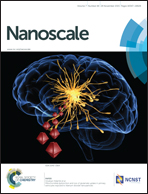Poly-adenine-based programmable engineering of gold nanoparticles for highly regulated spherical DNAzymes†
Abstract
Enzyme complexes are assembled at the two-dimensional lipid membrane or prearranged on three-dimensional scaffolding proteins to regulate their catalytic activity in cells. Inspired by nature, we have developed gold nanoparticle-based spherical DNAzymes (SNAzymes) with programmably engineered activities by exploiting poly-adenine (polyA)–Au interactions. In a SNAzyme, AuNPs serve as the metal core, which is decorated with a functional shell of DNAzymes. Conventional thiolated DNAzyme-based assembly leads to disordered structures with suppressed activity. In contrast, by using an anchoring block of polyA tails, we find that the activity of SNAzymes can be programmably regulated. By using a polyA30 tail, SNAzymes demonstrated remarkably enhanced binding affinity compared to the thiolated DNAzyme-based assembly (∼75-fold) or individual DNAzymes in the solution phase (∼10-fold). More significantly, this increased affinity is directly translated to the sensitivity improvement in the SNAzyme-based lead sensor. Hence, this design of SNAzymes may provide new opportunities for developing biosensors and bioimaging probes for theranostic applications.


 Please wait while we load your content...
Please wait while we load your content...